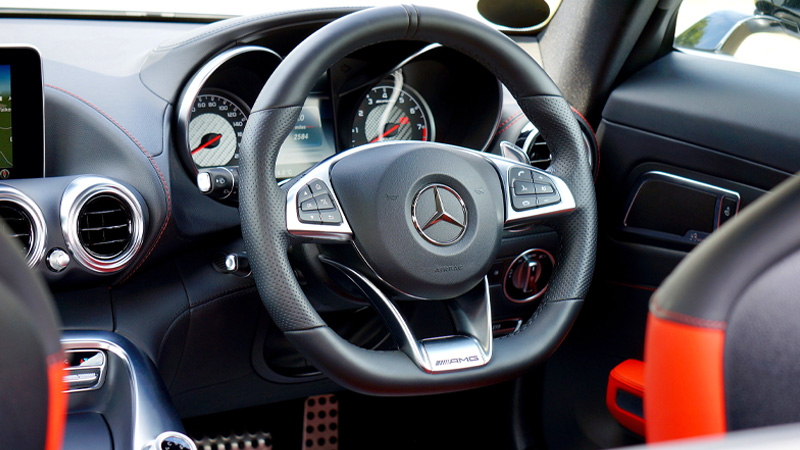We use cookies to make your experience better. To comply with the new e-Privacy directive, we need to ask for your consent to set the cookies. Learn more.


Mercedes-Benz Innovations of Standard Safety Features
Mercedes-Benz is renowned for its invention and implementation of the safety features we take for granted in our vehicles today.
The brand has been a pioneer in safety for decades, including Active Safety – avoiding risks, warning in good time, and acting in a preventative measure, and Passive Safety – providing appropriate protection, preventing worse situations, and providing fast assistance.
We’ve compiled a timeline that shows exactly when certain safety features were implemented, adding a whole new standard to vehicle safety and driving.
1931
New independent wheel suspensions were introduced on the 170 model, making it the first series production passenger car with hydraulic brake system and independent wheel suspension on the front and rear axle.
1959
The elegant body of the 220, 220 S and 220 SE models has a specific design feature – the tail fins, giving a whole generation of vehicles the nickname ‘tail fin Mercedes’. As well as this significant design, the vehicle features the world’s first safety body. For the first time, the Barényi patent was implemented in a production car with defined crumple zones in conjunction with a high-strength passenger cell, representing a milestone in passive safety.
1978
Antilock Brake System (ABS) was introduced for the first time in the S-Class (W 116) in 1978. Since then, ABS has been available continuously in Mercedes-Benz models, initially as optional equipment and then later as part of the standard equipment. The advantage of ABS is that the wheels do not lock when braking, allowing the driver to still steer the vehicle.
1981
The world’s first driver’s airbag was implemented. Airbags and seatbelt tensioners became available in a series production passenger car for the first time. As of 1982, the driver’s airbag was available in all models, followed by the front-passenger airbag in 1987 and side airbag in 1995.
1995
Electronic Stability Control (ESP) was introduced in the S 600 Coupé. As of 1999, all Mercedes-Benz passenger cars are equipped with ESP as standard.
1996
World premiere of Brake Assist System (BAS) in passenger cars, allowing detection of emergency braking and, where necessary, establishing the maximum brake boost automatically and faster than before, significantly reducing the vehicle’s braking distance.
1997
Automatic Child Seat Recognition (ACSR) was incorporated into vehicles. If a BABY-SAFE plus child seat is secured to the front passenger side, the airbag electronics detect that a child seat is positioned here and deactivates the front-passenger airbag automatically. If the child seat is removed, the airbag is operational again automatically.
1998
The first Tridion safety cell was implemented in the smart car. Becoming a role model for active and passive safety, the Tridion safety cell protects the passengers in the same way as a hard nutshell.
2002
The world premiere of PRE-SAFE in the S-Class signalled Mercedes-Benz’s role as a trendsetter in safety innovation. PRE-SAFE uses sensor information to detect typical accident situations before they occur, and to activate preventative protective measures for the occupants as a reflex, so that the seat belts and airbags, for example, can employ their full protective effect in the event of a collision.
2005
Crash-responsive, the NECK-PRO active head restraints are exclusive to Mercedes-Benz. They’re activated in the event of a rear-end collision, supporting the head earlier and thereby reducing the risk of whiplash.

2006
The PRE-SAFE Brake is incorporated into the Mercedes-Benz CL-Class. In crash simulations, Mercedes engineers determined that the PRE-SAFE Brake can reduce the severity of the impact by up to 40 percent in the event of a collision.
2006: The Intelligent Light System ensures perfect light distribution over the road surface depending on the driving conditions.
2007
Blind Spot Assist informs the driver if the lane change is too dangerous by displaying a red warning signal in the exterior mirror. To do so, it uses radars to detect the area immediately next to and behind the vehicle.
2009
ATTENTION ASSIST detects drowsiness and warns of dangerous microsleep in good time. The system is equipped with highly sensitive sensors which detect the driver’s driving characteristics and over 70 other parameters. In this way, the system detects a lack of attention by the driver.
2010
Active Brake Assist 2 initiates emergency braking if there a risk of collision with a vehicle in front or a stationary obstacle, for example in the event of a sudden traffic jam on the motorway.
2010
Active Lane Keeping Assist uses a camera on the windshield to detect the roadside markings, and which it uses to determine if the vehicle is leaving the lane unintentionally. The driver is then warned with steering wheel vibrations that can be clearly felt. If there is still a risk of driving across a continuous line, the wheels are braked specifically by means of ESP intervention in order to guide the vehicle back into the lane. A visual display in the instrument cluster also provides a warning.
2010
Night View Assist PLUS uses infrared technology to improve visibility in situations when the main beam headlamps cannot be used. Night View Assist Plus also features pedestrian recognition, which marks any persons detected on the road in the display.
2010
The fully dynamic LED headlamps provide all the adaptive light functions of modern Xenon systems: country road mode, active light function and cornering light function.
2011
Collision prevention assist recognises a risk of a front-end collision at an early stage and warns the driver visually and acoustically if there is a risk of collision. If the driver then brakes, Adaptive Brake Assist can reinforce the braking pressure as required to prevent the collision.
2013
As part of its Intelligent Drive strategy, Mercedes-Benz brings Car-to-X technology to the road, thus enabling information to be exchanged between vehicles and the transport infrastructure. By using Car-to-X technology, information about potential hazards in road traffic are communicated to the drivers at an early stage so they can be prepared and so that critical situations do not occur in the first place.
2014
Mercedes-Benz is the first vehicle manufacturer to offer digital access to a vehicle-specific rescue card by means of QR code. Once the QR code has been scanned using a mobile end device, the relevant vehicle information for rescuing passengers is available. This includes cable routes or application points for the fire brigade’s hydraulic cutters. The QR code sticker is integrated in all new Mercedes-Benz and smart passenger cars and can now also be retrofitted for older models.
Find out what services we offer to emsure your car runs smoothly and safely.
